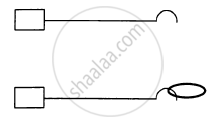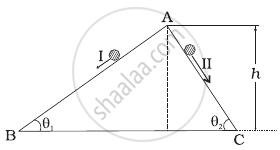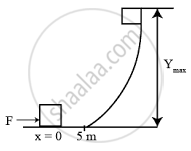Advertisements
Advertisements
Question
In a shotput event an athlete throws the shotput of mass 10 kg with an initial speed of 1 ms–1 at 45° from a height 1.5 m above ground. Assuming air resistance to be negligible and acceleration due to gravity to be 10 ms–2, the kinetic energy of the shotput when it just reaches the ground will be ______.
Options
2.5 J
5.0 J
52.5 J
155.0 J
Solution
In a shotput event an athlete throws the shotput of mass 10 kg with an initial speed of 1 ms–1 at 45° from a height 1.5 m above ground. Assuming air resistance to be negligible and acceleration due to gravity to be 10 ms–2, the kinetic energy of the shotput when it just reaches the ground will be 155.0 J.
Explanation:
If air resistance is negligible, the total mechanical energy of the system will remain constant. And let us take the ground as a reference where potential energy will be zero.
According to the problem, h = 1.5 m, v = 1 m/s, m = 10 kg, g = 10 ms– 2
The initial energy of the shotput = `(PE)_i + (KE)_i`
= `mgh + 1/2 mv^2`
= `10 xx 10 xx 1.5 + 1/2 xx 10 xx (1)^2`
= 150 + 5
= 155 J
From the conservation of mechanical energy,
`(PE)_i + (KE)_i = (PE)_f + (KE)_f`
⇒ `155_j = 0 + (KE)_f`
So, the final kinetic energy of the shotput is 155 J.
APPEARS IN
RELATED QUESTIONS
A body is initially at rest. It undergoes one-dimensional motion with constant acceleration. The power delivered to it at time t is proportional to ______.
Figure shows a particle sliding on a frictionless track which terminates in a straight horizontal section. If the particle starts slipping from point A, how far away from the track will the particle hit the ground?

A block of mass m is attached to two unstretched springs of spring constants k1 and k2 as shown in the following figure. The block is displaced towards the right through a distance x and is released. Find the speed of the block as it passes through the mean position shown.

A small heavy block is attached to the lower end of a light rod of length l which can be rotated about its clamped upper end. What minimum horizontal velocity should the block be given so that it moves in a complete vertical circle?

Figure following shows a light rod of length l rigidly attached to a small heavy block at one end and a hook at the other end. The system is released from rest with the rod in a horizontal position. There is a fixed smooth ring at a depth h below the initial position of the hook and the hook gets into the ring as it reaches there. What should be the minimum value of h so that the block moves in a complete circle about the ring?

A spring of negligible mass and force constant 5 Nm–1 is compressed by a distance x = 5 cm. A block of mass 200 g is free to leave the end of the spring. If the system is released, what will be the speed of the block when it leaves the spring?
A body is falling freely under the action of gravity alone in vacuum. Which of the following quantities remain constant during the fall?
Two inclined frictionless tracks, one gradual and the other steep meet at A from where two stones are allowed to slide down from rest, one on each track as shown in figure.

Which of the following statement is correct?
A body falls towards earth in air. Will its total mechanical energy be conserved during the fall? Justify.
A force shown in the F-x graph is applied to a 5 kg cart, which then coasts up a ramp as shown. The maximum height, ymax is ______ m, at which the cart can reach.
(g = 10 m/s2)


